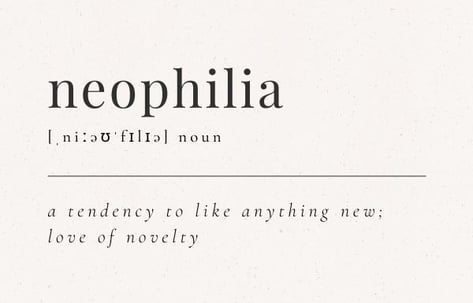Why you should embrace your inner neophile.
/4.png?width=200&name=4.png)
Neophilia? 🤯
Yep, you read that correctly.
Meaning a love of novelty, the term comes from ancient Greek ‘Neo’ - for ‘new’ and ‘philia’, 'to love’ - and I’d definitely be careful how you Google it!
On a more serious note, neophilia is an umbrella term for the behaviours and habits seen in successful, modern leaders.
Innovation and transformation are hard. The constant drive for new ideas, new approaches and new products can be exhausting. But, according to Gartner, digital leaders can overcome this fatigue by cultivating neophilia - that is, being curious about newness.
So, here’s 3 reasons to embrace your inner neophile.
1. Embrace adaptation, become more resilient.
Near constant digital disruption means that inflexible customs and habits can limit your ability to lead with the dynamism required in times of disruption, and to create a pro-innovation culture.
Cultivating neophilia can help digital leaders to avoid getting trapped in familiarity. Traditional thinking may suffice when dealing with the routine, but when the old ways no longer work - or the path before you is an uncertain one - it’s essential to be able to break the mould and seek new ideas and solutions.
Neophiles can therefore be more resilient, able to manage multiple volatile and uncertain situations and to adapt as required. However, leaders who find that they always thrive in conditions that seem chaotic to others, or who never choose tried-and-tested methods, should exercise caution - neophilia is curiosity about the new, but it is tempered by experience. It should be a habit, but not a religious one.
2. The role of the CIO is changing, and becoming more strategic.
95% of CIOs surveyed by IDG said their role was expanding beyond traditional IT responsibilities.
IDG also found that most CIOs are spending more time on aligning IT projects with business goals (44%), leading business innovation (34%), and leading organisational change programs (34%).
CIOs are taking their place alongside other business leaders and leading strategic initiatives - and to become better leaders, they should become more comfortable with embracing the new.
As Gartner says: “embracing neophilia requires the development of certain habits that enable leaders to visualise new ways of doing things. Over time, these practices become second nature…"
being a neophiliac endows leaders with the ability to solve problems and overcome the neural barriers that can impede them from looking beyond the status quo.
- Apoorva Chhabra & Mary Mesaglio, Gartner.
3. Your learning culture affects your skills retention.
Your personal, and organistional, learning culture impacts your ability to embrace the new - and can directly impact your ability to recruit and retain staff.
4/10 software developers are thinking about quitting their jobs this year. Given the current imbalance between supply and demand of tech skills, and the increased costs of hiring in new tech talent, training and development of current staff can be more cost effective and also boost retention and morale.
if you want a diverse population of people with emerging skill sets, you are generally much better off retraining your own folks.
-Melissa Swift, in an interview with CIO Dive.
Believing that learning is restricted to the classroom or listening to experts limits inquisitiveness; instead, leaders should model a learning culture which is rooted in observation, self-discovery and self-direction. Top-down didactic practices tend to replicate knowledge, but do not provide room for curiosity and ‘out of the box’ thinking.
How to become a neophile:
- Recognise and deconstruct unconscious biases;
- Habitually expose yourself to new and different stimuli;
- Shift your learning style from observation to self-discovery;
- Collaborate based on your weaknesses, not just your strengths;
- Get out of your comfort zone.
Resilience in practice
Skills and behaviours are a really important part of building both personal and organisational resilience - fitting into the People and Innovation dimension. But there are other dimensions to a resilience strategy too, which are explored in our Complete Guide to Operational Resilience:
- People
- Innovation
- Automation
- ESG
- Regulation
- Composability
- Continuity.
The Guide breaks down each of these dimensions into a set of resilience capability indicators, allowing organisations to be measured and providing insight that your teams, investors, customers and regulators will be keen to understand.
Download your copy now:
Sources:
Apoorva Chhabra & Mary Mesaglio, Gartner Research Note: "The Future of Work Requires Digital Leaders to Be Neophiliacs", June 2022.
